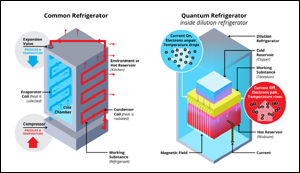Researchers develop superconducting quantum refrigerator
5. 6. 2019 | University of Rochester | www.rochester.edu
Imagine a refrigerator so cold it could turn atoms into their quantum states, giving them unique properties that defy the rules of classical physics.
In a paper published in Physics Review Applied, Andrew Jordan, professor of physics at the University of Rochester, and his graduate student Sreenath Manikandan, along with their colleague Francesco Giazotto from the NEST Istituto Nanoscienze-CNR and Scuola Normale Superiore in Italy, have conceived an idea for such a refrigerator, which would cool atoms to nearly absolute zero temperatures (about minus 459 degrees Fahrenheit). Scientists could use the refrigerator, which is based on the quantum property of superconductivity, to facilitate and enhance the performance of quantum sensors or circuits for ultrafast quantum computers.

The inner workings of a superconducting quantum refrigerator
In the superconducting quantum fridge, researchers place a layered stack of metals in an already cold, cryogenic dilution refrigerator:
- The bottom layer of the stack is a sheet of the superconductor niobium, which acts as a hot reservoir, akin to the environment outside a traditional refrigerator
- The middle layer is the superconductor tantalum, which is the working substance, akin to the refrigerant in a traditional refrigerator
- The top layer is copper, which is the cold reservoir, akin to the inside of a traditional fridge
Read more at University of Rochester
Image Credit: Michael Osadciw
-jk-




